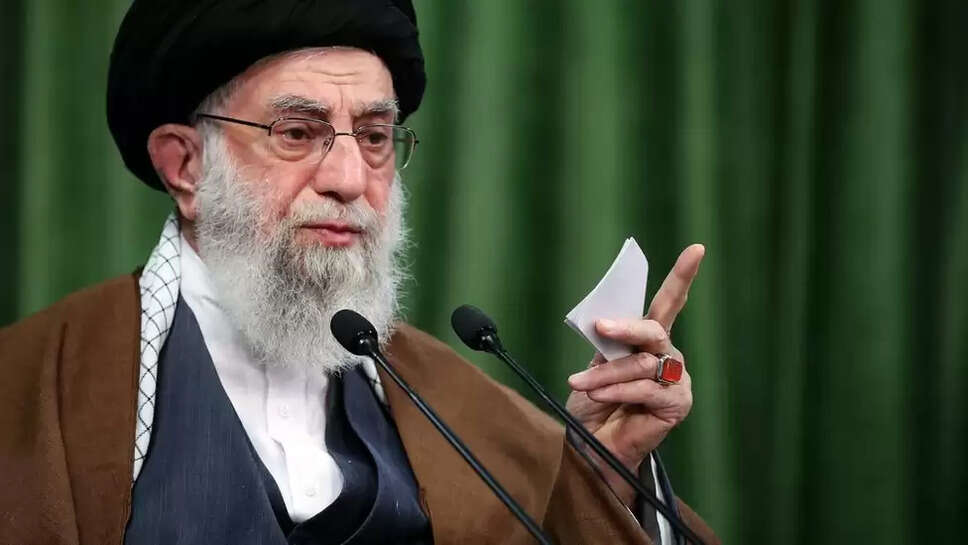The Silent Power: Speculation Grows Over Ayatollah Khamenei’s Whereabouts

Iran’s Supreme Leader, Ayatollah Ali Khamenei, is one of the most powerful and secretive figures in global politics. As the country’s highest authority since 1989, his influence extends beyond religious leadership—into politics, military affairs, foreign policy, and the socio-cultural fabric of Iran. Over the years, his rare public appearances, limited interviews, and tightly controlled communications have cultivated an aura of mystery around him.
But every so often, questions arise: Where is he now? Why has he not been seen in public for a while? Is he ill? Is he still in control?
As Iran goes through significant domestic and international turmoil—including economic challenges, tensions with the West, and shifting regional alliances—the absence or limited visibility of Khamenei raises speculation both within and beyond Iran’s borders. Here's a closer look at why the question of “Where is Ayatollah Ali Khamenei?” matters, and what could be happening behind the scenes.
Who Is Ayatollah Ali Khamenei?
Before diving into his whereabouts, it’s important to understand who Khamenei is. Born in 1939 in Mashhad, Iran, Khamenei rose through the ranks of the Shiite clergy and became a close ally of Ayatollah Ruhollah Khomeini, the leader of Iran’s 1979 Islamic Revolution. After serving as President of Iran in the 1980s, Khamenei was appointed Supreme Leader following Khomeini's death in 1989.
The Supreme Leader is not just a symbolic figure. He has the final say over almost every matter in the country, including:
-
The military and Revolutionary Guards
-
The judiciary
-
State media
-
Presidential and parliamentary candidate approvals
-
Foreign policy, including nuclear negotiations
Khamenei’s words are seen as near-sacred by hardliners and his loyal followers. His health and visibility are often viewed as reflections of Iran's political stability.
Why the Mystery Around His Whereabouts?
The question of “Where is Khamenei?” tends to surface whenever there is a prolonged absence from public view, a cancellation of a major appearance, or circulating rumors about his health. In the past, there have been moments where the lack of updates from official channels has led to speculation, only for the Supreme Leader to reappear days or weeks later in a pre-recorded or live broadcast.
Several factors contribute to this mystery:
-
Secrecy by design: Iran's leadership structure is not transparent. Details about the health or whereabouts of top leaders are rarely shared.
-
Age and health concerns: Khamenei is 85 years old. Past rumors have mentioned health issues including prostate cancer, though these have never been confirmed by Iranian authorities.
-
Political sensitivity: Any uncertainty around Khamenei’s status could create instability, especially in a nation facing internal dissent and external pressures.
Where Might He Be?
While exact details are rarely made public, there are a few locations where Ayatollah Khamenei is known to operate from or reside in:
1. Beit-e Rahbari (The Supreme Leader’s Office) – Tehran
This is the central hub of Khamenei’s leadership. Located in Tehran, it is both a residence and an administrative center, often referred to as "The Leader’s House." It’s heavily guarded and serves as a key venue for private and public meetings.
2. Jamaran Hussainiya – Tehran
This religious center has historically been used for speeches, sermons, and public addresses by Iran’s leaders. Khamenei has delivered numerous sermons from here, including the annual Eid prayers and other significant events.
3. Medical Facilities and Retreats
It is widely believed that Khamenei has access to specialized medical facilities, including a hospital within his compound or nearby secure locations. When not visible for long periods, it is often assumed that he may be resting, recovering, or undergoing routine health checks.
Health Rumors and Past Absences
Rumors about Khamenei’s health have been recurring for over a decade. Several times, his reduced public appearances have sparked discussions around potential hospitalizations or surgeries. For instance:
-
In 2014, reports emerged that he had undergone prostate surgery. The operation was later confirmed by state media, and Khamenei himself appeared in a hospital bed, greeting visitors and speaking calmly.
-
In 2022, there were reports suggesting that he had become gravely ill and had canceled important meetings. Again, within days, he appeared in public, seemingly dismissing the concerns.
The Iranian state machinery is highly adept at controlling such narratives. When needed, pre-recorded videos are aired to assure the public. Photographs of meetings—often with high-ranking officials or visiting dignitaries—are published to signal continuity.
Why It Matters: Political Implications
In a system like Iran’s, the health and visibility of the Supreme Leader aren't merely personal matters—they have deep national and geopolitical consequences.
1. Succession Uncertainty
Khamenei’s eventual successor has not been officially named. Although speculations surround figures like his son Mojtaba Khamenei or other senior clerics, no clear plan has been made public. Any hint that Khamenei is incapacitated could trigger behind-the-scenes power struggles.
2. Regional Stability
Iran is involved in multiple regional issues—from supporting militias in Lebanon and Iraq to its nuclear standoff with the West. The perception of a power vacuum at the top could embolden adversaries or spark internal factionalism.
3. Domestic Protest Movements
Iran has seen waves of anti-government protests, especially since 2019 and during the 2022 Mahsa Amini movement. Khamenei is often seen as the ultimate figure of authority, and his prolonged silence can add fuel to already fragile public sentiments.
His Recent Appearances (or Lack Thereof)
In most cases, when the question “Where is Khamenei?” gains traction, it is answered with a photo op or a video appearance. He is seen meeting with students, military leaders, or delivering a virtual address. However, in recent times, such appearances have grown rarer, shorter, or more tightly choreographed—fueling speculation further.
When he does appear, analysts look closely at every detail: how he speaks, how long he talks, whether he’s standing or seated, who he meets, and what topics he chooses to address.
A Symbol Beyond Politics
For many in Iran, especially those aligned with the Islamic Republic’s ideology, Khamenei is more than just a political leader—he is a spiritual figure, a symbol of resistance, and a link to the revolution’s roots. For others, especially younger, reform-minded Iranians, he represents an outdated hierarchy that they wish to move beyond.
This sharp divide in perception only adds to the intensity surrounding his visibility—or absence.
Presence Through Silence?
Ayatollah Ali Khamenei remains a central figure in Iran’s story, and whether he is visible or not, his influence persists. But every time he vanishes from public view—even briefly—it reveals just how dependent the Iranian system remains on one man.
In a country shaped by revolution, ideology, and control, even a whisper about the Supreme Leader’s absence can carry immense weight. Until he appears again—live, seated, waving—the question will echo: Where is Ayatollah Khamenei?
